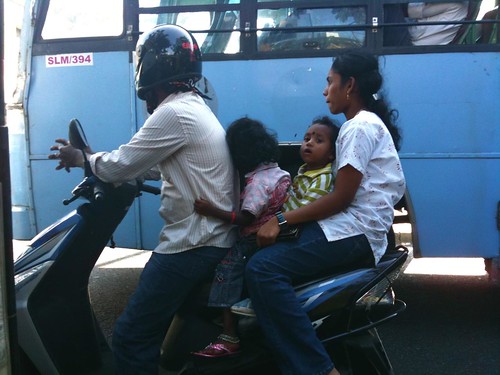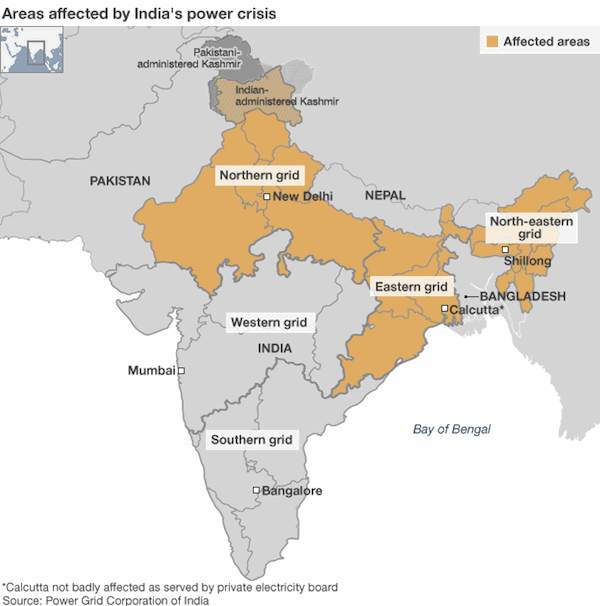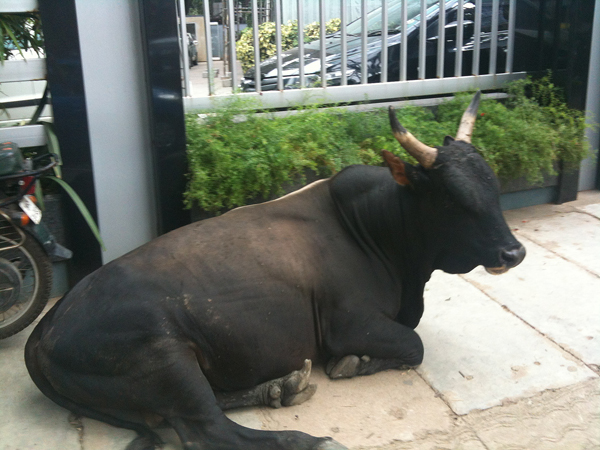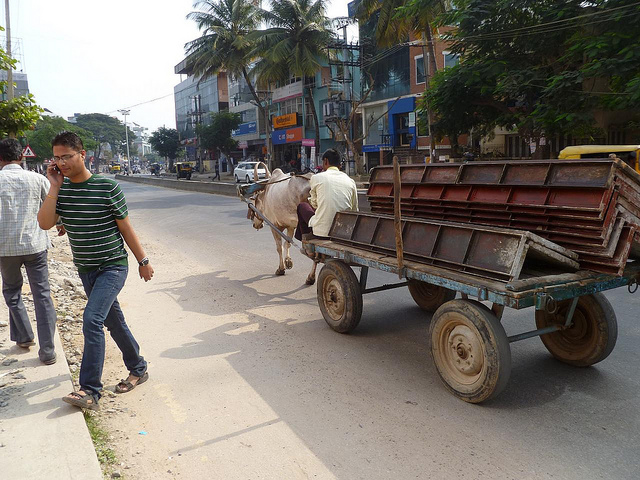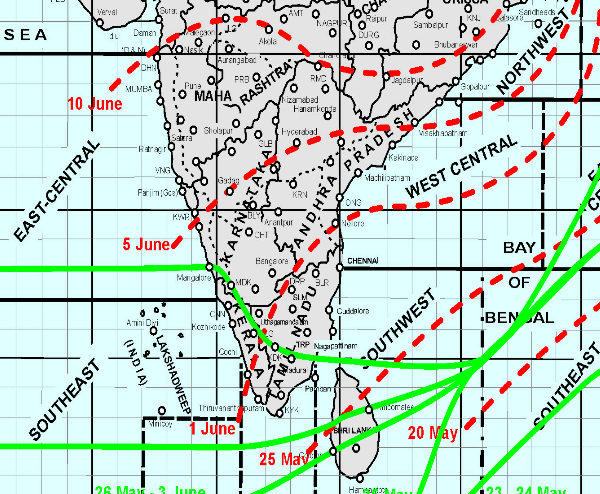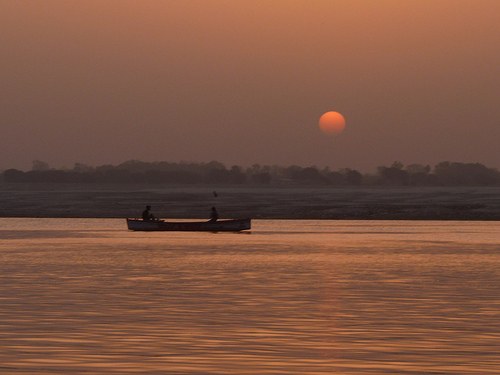I’m only just finishing off writing this post in July, but the last bit of holiday I managed to take was our “term break” in the last week of March. I took a short trip away to see another bit of India — this time up to the Northern state of Uttar Pradesh, or U.P. as it’s known.
I got away for a whole 7 days, which is the longest I’ve been off work since arriving here in December 2010. It was a very welcome break, and great to finally travel to one of the most iconic parts of India — the area around the Ganges river.
I started off by flying from Bangalore up to Lucknow, surprisingly about 1800km away and a flight lasting 2hrs 20. When you look at a map of India it’s easy to forget the size of the place!
After an intense final week of term at work and getting exactly 1 hour of sleep before catching a very early flight, I can’t say I really did much in Lucknow the first day, apart from sleep a lot in the hotel and make the most of room service. But that’s what holidays are for, right? Next day I flew to Varanasi, about 300km South-East, and which was the main focus of my trip.
Varanasi
Brace yourself. You’re about to enter one of the most blindingly colourful, unrelentingly chaotic and unapologetically indiscreet places on earth. Varanasi takes no prisoners. But if you’re ready for it, this may just turn out to be your favourite stop of all.
— Lonely Planet India
I can’t argue with this. Varanasi — or Benares or Kashi as it’s variously known — is quite a place. One of the seven holy cities of Hinduism, it’s also one of the world’s oldest continuously-inhabited cities, originally founded during the Iron Age and extant as a city since around 1200BC. Hindu pilgrims go there to bathe in the holy Ganga (River Ganges), and dying here is said to offer Moksha, or liberation from the cycle of death, reincarnation and birth.
On the first night there I grabbed an auto-rickshaw from outside my hotel, and headed down to the focus of the city on the West side of the river. The auto driver seemed quite friendly, and helpfully pointed out places of interest on the half-hour journey, like National Highway 7 that cuts right through the ancient city like a scar full of huge lorries (Horn OK Please, very loud horns). So far, Varanasi looked like any other non-metro city I’d been in, with a lot more tricycle rickshaws, and quite a few more goats and buffaloes wandering the streets. Hot, noisy and sweaty, but I’m getting used to this now, and maybe even starting to enjoy it in a way. There’s something about the chaos that can become addictive.
Then the driver suddenly threw our auto into a narrow side-street, paved with stones, and I realised we were now in the old city proper. The tiny, meandering streets surrounded by high-sided buildings were ancient and formidable, and not really meant for motor vehicles. The street was only just wide enough for the auto on its own, and I was hanging on tight as he swerved to avoid children, cattle, on-coming motorbikes and all the usual stuff. (There’s a kind of very sharp swerving manoeuvre that you can do in an auto because it has motorbike handlebars rather than a steering wheel…)
The people dodging our auto began to look more… holy. Young monks, with their hair shaved off except on the very top, hurried from one place to another on seemingly urgent business, while chilled-out Sadhus (holy men) with long beards, piled-up dreadlocks and a multitude of different coloured pastes on their foreheads sat around in doorways with begging bowls, or just sleeping. Many of the buildings appeared to be temples, and incense was burning everywhere. We parked up and the driver told me that the Sadhus were “on strike” in protest at a government plan to damn the Ganges, along with other rivers, as part of a nationwide scheme to improve irrigation. He led me down a tiny alleyway and suddenly there we were, at the side of the river. Ma Ganga, Mother Ganges.
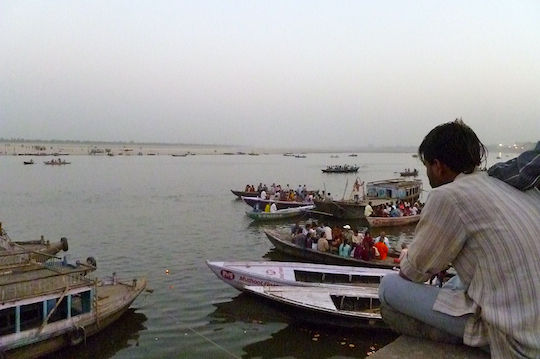
The key feature on the West Bank is the Ghats, literally steps, at the side of the river. Not only places for bathing in the holy Ganga, but pretty much everything else goes on here too… kids playing cricket, herds of cows and buffaloes hanging around, and a proper army of touts. I realised what the Lonely Planet was talking about — Varanasi really does go up to 11. The auto driver offered to wait for me, as they often do, and without really thinking I headed down the steep steps and plunged into the crowds.
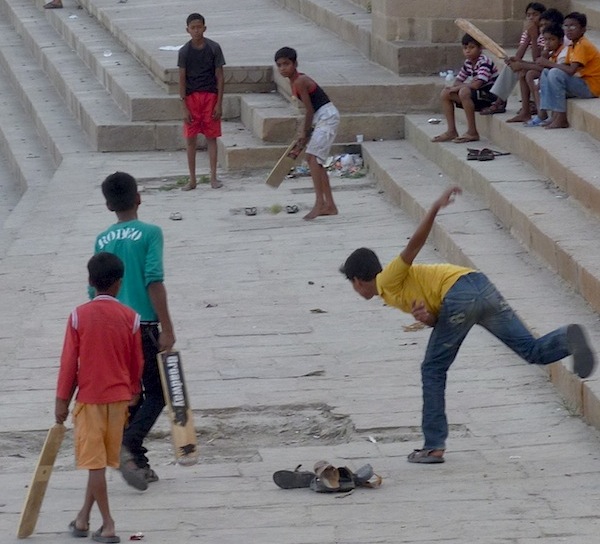
I’m certainly more thick-skinned than I was when I first arrived in India, and can now do a pretty decent version of the gesture that means “no thanks”… holding out the hand with fingers pointing upwards, palm pointing at the relevant person, and basically waving slightly. But this place was absolutely relentless. In the vain hope of wandering by the river and soaking up the atmosphere, I was constantly fighting my way through touts and vendors. “Boat trip, sir?” (repeat every 20 seconds.)
There seemed to be lots of lepers too… I always give something to people in a bad way if I can, since there’s no welfare system in India. Giving to beggars here is also supposed to bring good Karma, but I ran out of change almost immediately because there were just so many. I wished I’d known and taken more change… it doesn’t feel good to turn down people who are obviously in great need, guaranteed Karma or not.
Just when I felt like I was getting into the swing of things, a bald old man with a neat grey moustache and Gandhi glasses appeared out of nowhere and grabbed my right wrist with both of his surprisingly powerful hands. It felt just like a move I used to do in Aikido, and I wondered if he was about to try and throw me over his shoulder. Then, as his hands worked their way forcefully up my forearm I asked him what he was doing. “Ayurvedic massage, sir”. Oh, right. Meanwhile a young girl carrying a baby had appeared on my other side, asking for money. At this point, immobilised and surrounded, I thoroughly expected to have my pockets picked, and stood there very tensely — trying to keep some awareness on my valuables (camera left pocket, check; phone right pocket, check) — while this old guy, who wouldn’t be told “no”, gave my arm a right old Ayurvedic seeing-to. Once this free sample was over he let go, and I couldn’t get away quick enough while he was explaining his tariff of various treatments. “Thanks, maybe later…”
Wandering up river I ended up at the Dasaswamedh Ghat, which was getting quite busy with the crowds sitting around waiting for something, and many people going down the steps to the water, to pray, bathe, make offerings, get into one of the many boats, or to light small floral lamps — conveniently being sold by an army of children — which they then put in the water to sail gently away.
As the sun began to set I managed to find a place to sit looking across at the Ghat, which has a small square at the top with market stalls selling flower garlands, incense and various other puja supplies. Surrounded by Indian families, I was suddenly unmolested, and could happily sit people-watching and taking photos. A couple of large, precariously-wired speakers were pumping out distorted but otherwise traditional songs in Hindi, one of which seemed to be about going to Varanasi and doing something important.
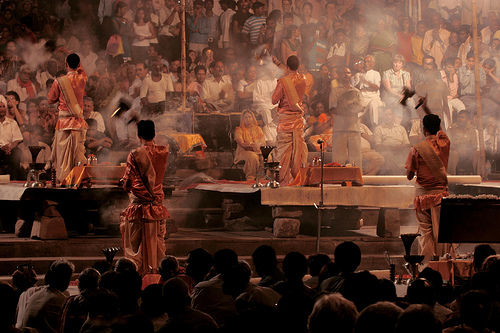
Ganga Aarti.
Photo by whl.travel @ flickr.
Shortly after sunset five young men dressed in saffron robes appeared, and each knelt next to one of the five low tables that had been set up facing the river. The music on the speakers changed to something being played live by unseen musicians, and everyone began to clap along. Various rituals then went on, involving flames, big incense burners, blowing of conch shells, ringing of many bells etc. and I realised this is what everyone had been waiting to see. Just after sunset every day, the Ganga Aarti is performed — an offering to the sacred river. The whole thing was very lively and joyful — not reverent or serious as you might expect — with lots of clapping and singing along. It was captivating. Watching the aarti, and watching the people to whom this was obviously so significant and important, I lost track of time completely, until I wondered how long it had been since the auto driver had dropped me off. Then I realised I hadn’t even paid him!
Picking my way back down the badly-lit riverside as best I could in the dark, I wondered if he was still waiting, and felt a bit sorry for him. Sure enough, someone in the darkness called by my shoulder — “Sir!”, and there he was. He’d been waiting 2½ hours, but didn’t seem bothered at all. He was keen to pick me up in the morning and bring me back for a boat trip, and since I was planning to do that anyway, I agreed. 5am pick-up from the hotel, then. Accha. Good.
* * *
The alarm on my phone wakes me next morning at 4.30am, and sure enough when I look out of the hotel window, the auto driver is pacing back and forth outside in the dark waiting for me.
Driving around before dawn in India feels special somehow. Apart from it being pleasantly cool — around 20°C in this case — you see things you don’t easily see otherwise. Vegetable vendors pushing their hand-carts down the street, from wherever it is they might live (possibly a slum), to wherever it is that they sell their wares (probably the bazaar). A white-capped man and his young white-capped son, walking to a mosque for early prayers. A large group of teenage boys squatting barefoot at the side of the road, fastening newspapers into bundles for delivery while bicycles sleep all around them.
And it’s just peaceful. Although plenty of people are up and about, there’s no motor traffic to speak of, and the constant car-horns haven’t yet started. You can even hear birdsong! Before sun-up is a magical time of day here. The air even tastes clean-ish.
The auto driver takes pretty much the same route as last night, making the same sudden turn into a side-street to gain access to the old part of the city, and we’re by the side of the river again, although now it’s 5.30am and still dark. As expected, the driver introduces me to his friend the boat owner who offers his services, but I decide to head off to do my own thing, so I pay the driver and this time I remember to tell him not to wait.
There are plenty of people about considering it’s so early, but it’s not as crowded as last night. As I walk up the river, from Ghat to Ghat, I can hear singing and clapping from inside a temple with people sitting around outside, and I get the impression that they’ve been going all night. The sun hasn’t come up yet but it’s fairly light now. As I walk past the busier Ghats I ignore the offers of joining boat-loads of tourists and head a bit further up to a quieter place, where I find myself a chilled-out looking boatman who will take me out on my own.
We agree a price, get into his rowing boat, and as if by magic a small boy appears, selling floral lamps which are basically a paper dish with a candle and some flowers in it. Exercising my now-ruthless haggling skills (mainly because I have almost no change, again) I buy just one, and we set off down the river.
It’s hard to find the words to describe this boat trip. Blissful, at last. Serene. Finally I felt like this is what I had been hoping for, when I knew I was moving to India. A sacred river at dawn, in a 3000 year-old city. The kind of impressive stuff you see on TV, but only really get to experience if you have time to be a tourist, not an ex-pat. The months of living in Bangalore with the stress and the dust and the traffic and noise just fell away. I watched and I listened. Just the lapping of the waves and the dipping of the oars, and the many Ghats and temples slipping slowly by.
Suddenly I’m interrupted from my rapture, and the boatman — whose name is Lalu — points behind me. The sun is just coming up. Perfect. As we sail down-river, I realise that all the buildings are on the West bank of the Ganga, looking East. Saluting the rising sun, and bathed in saffron-coloured light.

We carry on down the river, slowly, but with all the time in the world. It’s hard to tell Lalu’s age, but he has plenty of grey hair and looks like he’s been doing this for years. He’s working hard, but he looks strong. Every now and again he’ll point out something on the river-bank. “Maharaja’s Palace”. “Burning Ghat”. And that’s about it. No hard sell, no trying to rip me off, and I’m very grateful for that.

At one point another rowing boat piled up with tourist tat pulls up alongside. “Souvenir Shop!”, Lalu quips. The Souvenir-Shop Boatman smiles, Lalu smiles, and I smile too. “Thanks, I don’t need”, and I practice my waving gesture that means “No” again. The souvenir shop sails by.
It’s about 7am on a Sunday. Further down-stream, the riverside starts to get quite busy. Hundreds of people gather on the Ghats to bathe in the sacred river, and to pray. Some of them are singing and chanting. It feels very holy, and quite moving. But at the same time it’s very joyful and bursting with colour.

By this point there are quite a few tourists like me in boats, zipping up and down and clicking photos of the religious festivity. I feel a bit uncomfortable as the boat gets really close to some young monks standing up to their chests in the water, with their palms together and eyes closed, praying. I put my camera away, doing my best to respect their privacy (which Lalu doesn’t seem too worried about), and gradually we glide quietly past and leave them to it.
We carry on down the river, and eventually get to a point beyond which there doesn’t seem much to see. I tell the boatman he can turn around now, so he pulls up to the now-sandy riverbank, very close to 2 men wearing saffron robes who are bathing in the shallow water, joined by a couple of young crows. He jumps ashore and takes a dump a few feet away from where the men are performing their holy rituals. It seems that India is always good at bringing you back down to earth just when you start getting any ideas that might be a bit too romantic…
And so finally we head back up the river. Lalu must’ve been rowing for about an hour and a half now, but he doesn’t show any sign of being tired. I am surprised to notice that the muscles in my face are aching, and it dawns on me that I must have been grinning for the entire journey without realising it.
And somehow, knowing that I am happy makes me feel even more happy.
